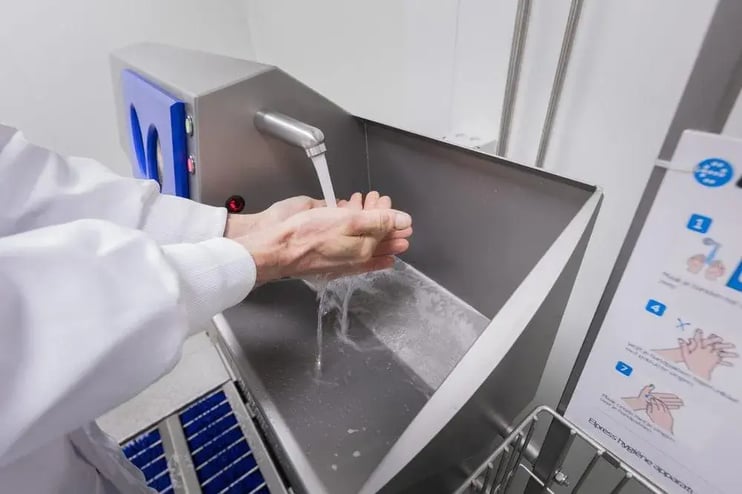What is the importance of a cleanroom and how do you clean it?

Developments in our living environment and the growing importance of optimal hygiene in the production and processing process are making the requirements for this increasingly stringent. Not only in the food industry, but also in the pharmaceutical industry, the chip industry and in the care sector. In this blog, read about what role a cleanroom plays in this and the best way for you to clean it.
What is a cleanroom?
A cleanroom is a work environment that is specifically designed to limit and control contamination caused by particles of (fine) dust, fibres, micro-organisms, droplets or (chemical) vapours as much as possible during the production and/or processing process. This is achieved through a specific design, set-up and use of the area which allows the number of “contaminating” particles to be limited, measured and controlled. In addition, the outside air is filtered through HEPA filters before it enters the cleanroom. And the air pressure inside the cleanroom is higher than the air pressure outside it. So that no contaminated air can penetrate it.
What sorts of cleanroom are there?
Cleanrooms exist in all sorts of sizes: from enormous areas containing the complete factory installation to an area of a few square metres or even a small area with just one workbench. They generally have a vertical airflow (except in high rooms, which often have a horizontal airflow) and are built using specific wall panels (monobloc, hardwall, softwall).
On the basis of the quantity and size of the particles in the air, the ISO 14644-1:2015 standards divides the clean rooms into specific classes: from ISO-1 (highest degree of cleanliness) to ISO-9 (lowest degree of cleanliness).
In which sectors are cleanrooms used?
Cleanrooms are used in many different sectors, such as in the:
- Food industry: for food safety, lactose- or gluten-free products, extending the use-by date of fresh products.
- Pharmaceutical industry: for safe medicines.
- Chip industry: for properly functioning chips and semiconductors.
- Care: for clean operating theatres.
- Laboratories: for clean tests.
- Sustainable energy: for highly absorbent solar panels.
What precautionary measures do users of a cleanroom have to take?
People are an important potential source of contamination. They always carry skin flakes and hairs on their person, as well as fibres and dust particles on their clothing. To prevent this contamination, the following precautionary measures, depending on the sector and legal requirements, are essential to a greater or lesser extent:
- Thorough and careful cleaning of hands.
- Wearing of special clothing: for example, hairnets or a cap, overalls, over-shoes or over-boots, mouth masks and gloves. These items are often made from polyester and are regularly washed in a special laundry and replaced.
- Entering the cleanroom via an airlock (sometimes with an air shower) and a sticky mat.
What criteria must a cleanroom comply with?
To prevent some products or an entire production line from becoming contaminated, it is important for the cleanroom to actually remain clean. So that work can be done cleanly and safely, the quality requirements can be complied with and public health is not put at risk.
For these reasons, cleanrooms must satisfy a number of criteria:
- Only those people who are trained on the process and on working in a cleanroom may access it.
- They must pass through all the hygiene procedures before they enter the cleanroom.
- The materials in the cleanroom must be impenetrable to micro-organisms, must not give off any dust and must be easy to clean.
- The cleanroom itself has an air circulation system that keeps unwanted (microscopically small) particles out.
How can you best use a cleanroom?
Each sector uses a cleanroom in its own way. But for all sectors, the following points help support optimal use of a cleanroom:
- Pay lots of attention to personal hygiene. Whatever does not enter the cleanroom does not also have to be cleaned.
• Provide suitable clothing. And make agreements on how to put it on, handle it and store it.
• Arrange the area so that equipment does not block the airflow.
• Move slowly so that the airflow and thus the particles are not disturbed too much.
• Only touch sterile materials with sterile instruments and replace these as often as necessary.
• Invest in well trained personnel.
• Clean the cleanroom regularly.
Tips for cleaning a cleanroom
Cleaning a cleanroom is an important element for using a cleanroom effectively. The following tips can offer support with this:
- Work according to a plan and schedule that are appropriate to the mandatory level of cleanliness (ISO class) and the requirements that are placed on the cleanroom in this regard.
• Establish procedures that clearly indicate how often, with which cleaning items and decontaminants, and which areas and parts of the cleanroom have to be cleaned.
• Ensure that a limited number of people are specifically involved in cleaning the cleanroom. The better they are equipped for this, the better the cleaning will be and the less unnecessary contamination is produced than when several people do the cleaning, but are less specialised in it.
• Provide tools, equipment, worktops, bins and baskets that themselves produce as little dirt as possible.
• Use low-dust paper and low-dust cleaning cloths and powder-free gloves.
• Ensure the most suitable form of cleaning. This is possible by cleaning the parts of the cleanroom with special foam, specific decontaminants or another cleaning method.
• Regularly check the air humidity of the cleanroom so that no additional measures have to be taken.
• Ensure that the cleanroom is dry and at the right temperature after cleaning. Check this just before locking the cleanroom and after a specified time.
Want to know more about a cleanroom and how to clean it?
Please contact us. We would be pleased to discuss this with you so that you can also reap the benefits of a clean cleanroom and are well prepared for the future. Would you like to know more about cleaning systems? Then download the white paper “An optimal cleaning process for every business”.
.webp)




